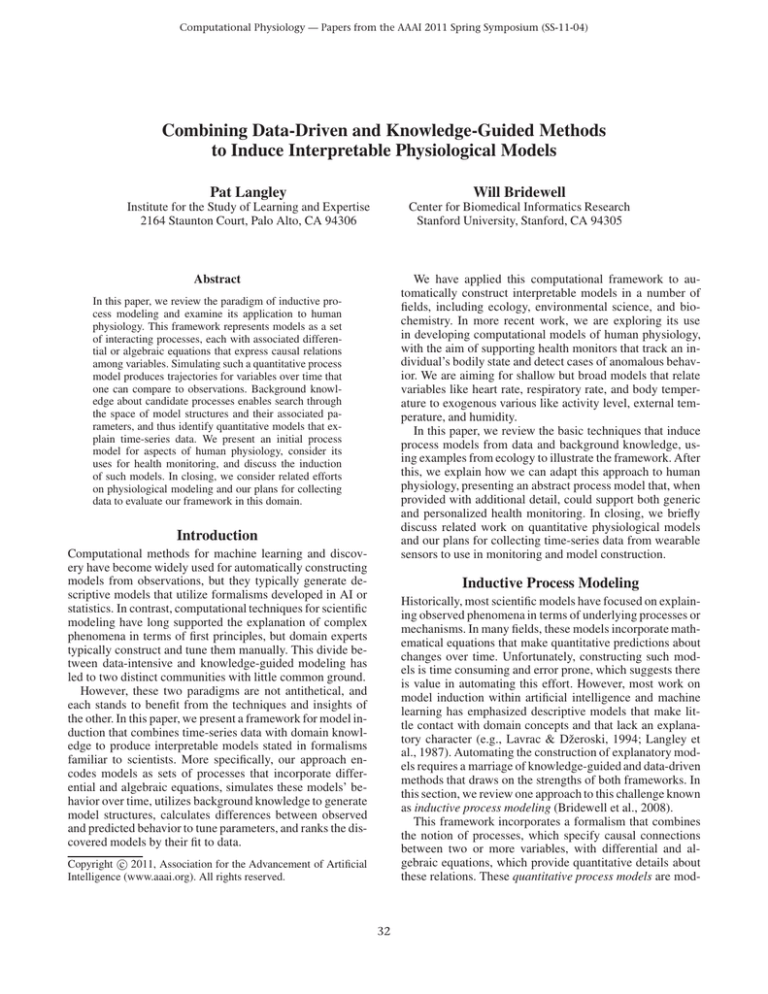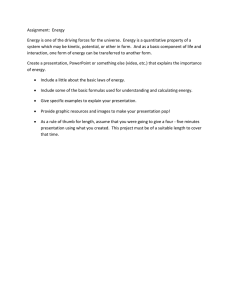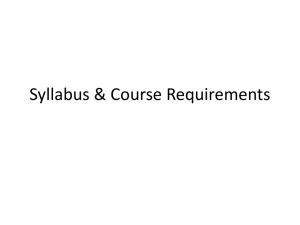
Computational Physiology — Papers from the AAAI 2011 Spring Symposium (SS-11-04)
Combining Data-Driven and Knowledge-Guided Methods
to Induce Interpretable Physiological Models
Pat Langley
Will Bridewell
Institute for the Study of Learning and Expertise
2164 Staunton Court, Palo Alto, CA 94306
Center for Biomedical Informatics Research
Stanford University, Stanford, CA 94305
We have applied this computational framework to automatically construct interpretable models in a number of
fields, including ecology, environmental science, and biochemistry. In more recent work, we are exploring its use
in developing computational models of human physiology,
with the aim of supporting health monitors that track an individual’s bodily state and detect cases of anomalous behavior. We are aiming for shallow but broad models that relate
variables like heart rate, respiratory rate, and body temperature to exogenous various like activity level, external temperature, and humidity.
In this paper, we review the basic techniques that induce
process models from data and background knowledge, using examples from ecology to illustrate the framework. After
this, we explain how we can adapt this approach to human
physiology, presenting an abstract process model that, when
provided with additional detail, could support both generic
and personalized health monitoring. In closing, we briefly
discuss related work on quantitative physiological models
and our plans for collecting time-series data from wearable
sensors to use in monitoring and model construction.
Abstract
In this paper, we review the paradigm of inductive process modeling and examine its application to human
physiology. This framework represents models as a set
of interacting processes, each with associated differential or algebraic equations that express causal relations
among variables. Simulating such a quantitative process
model produces trajectories for variables over time that
one can compare to observations. Background knowledge about candidate processes enables search through
the space of model structures and their associated parameters, and thus identify quantitative models that explain time-series data. We present an initial process
model for aspects of human physiology, consider its
uses for health monitoring, and discuss the induction
of such models. In closing, we consider related efforts
on physiological modeling and our plans for collecting
data to evaluate our framework in this domain.
Introduction
Computational methods for machine learning and discovery have become widely used for automatically constructing
models from observations, but they typically generate descriptive models that utilize formalisms developed in AI or
statistics. In contrast, computational techniques for scientific
modeling have long supported the explanation of complex
phenomena in terms of first principles, but domain experts
typically construct and tune them manually. This divide between data-intensive and knowledge-guided modeling has
led to two distinct communities with little common ground.
However, these two paradigms are not antithetical, and
each stands to benefit from the techniques and insights of
the other. In this paper, we present a framework for model induction that combines time-series data with domain knowledge to produce interpretable models stated in formalisms
familiar to scientists. More specifically, our approach encodes models as sets of processes that incorporate differential and algebraic equations, simulates these models’ behavior over time, utilizes background knowledge to generate
model structures, calculates differences between observed
and predicted behavior to tune parameters, and ranks the discovered models by their fit to data.
Inductive Process Modeling
Historically, most scientific models have focused on explaining observed phenomena in terms of underlying processes or
mechanisms. In many fields, these models incorporate mathematical equations that make quantitative predictions about
changes over time. Unfortunately, constructing such models is time consuming and error prone, which suggests there
is value in automating this effort. However, most work on
model induction within artificial intelligence and machine
learning has emphasized descriptive models that make little contact with domain concepts and that lack an explanatory character (e.g., Lavrac & Džeroski, 1994; Langley et
al., 1987). Automating the construction of explanatory models requires a marriage of knowledge-guided and data-driven
methods that draws on the strengths of both frameworks. In
this section, we review one approach to this challenge known
as inductive process modeling (Bridewell et al., 2008).
This framework incorporates a formalism that combines
the notion of processes, which specify causal connections
between two or more variables, with differential and algebraic equations, which provide quantitative details about
these relations. These quantitative process models are mod-
c 2011, Association for the Advancement of Artificial
Copyright Intelligence (www.aaai.org). All rights reserved.
32
such relationship may exist between any pair of species. The
data are continuous-valued time-series that are tied to variables in the model. Importantly, some variables may be hidden or theoretical, with no associated measurements.
Given background knowledge and data, an inductive process modeler will produce an account that both explains
the observations and offers predictions. The model induction phase involves two interleaved stages. First, the system
generates candidate structures by binding entities to generic
processes and combining these components in ways that observe the constraints. Second, it estimates the parameters of
these structures using a local optimization routine (Bunch
et al., 1993) coupled with random restarts. Finally, the system ranks the structures and returns the best explanations
based on their fit to the time-series data.
In previous work we have demonstrated the power of inductive process modeling in a variety of scientific domains.
The earliest applications dealt with simple population dynamics and battery performance (Langley et al., 2003), with
later work turning to the hydrodynamics of fjords (Asgharbeygi et al., 2006) and more complex ocean ecosystems
(Bridewell et al., 2008). We have also used the framework
to address problems in systems biology and biochemistry
(Langley et al., 2006).
Table 1: A process model of a predator–prey interaction between populations of foxes (f) and rabbits (r). The notation
d[X, t, 1] indicates dX/dt.
model Predation;
entities r{prey}, f {predator};
process rabbit growth;
equations
d[r.pop, t, 1] = 1.81 ∗ r.pop ∗ (1 − 0.0003 ∗ r.pop);
process fox death;
equations
d[f.pop, t, 1] = −1 ∗ 1.04 ∗ f.pop;
process predation holling 1;
equations
d[r.pop, t, 1] = −1 ∗ 0.03 ∗ r.pop ∗ f.pop;
d[f.pop, t, 1] = 0.30 ∗ 0.03 ∗ r.pop ∗ f.pop;
ular in that one can easily remove a process, add a new
one, or replace one process with another. Table 1 presents a
process model for a simple, two-species predator–prey system. Here there are three processes that characterize prey
growth, predator death, and predation. Each process contains equation elements that specify how one or more variables change over time. For example, predation holling 1
states how the density of the prey and predator populations combine to influence each other. When coupled with
the effects of fox death via addition, the resulting equation,
d[f.pop, t, 1] = −1∗1.04∗f.pop+0.30∗0.03∗r.pop∗f.pop,
provides an account of predator population dynamics. One
simulates the model by compiling it into a set of differential and algebraic equations, then calling a numerical solver
(Cohen & Hindmarsh 1996). The resulting trajectories are
available for analysis and comparison with observations.
Over the past few years, we have developed several systems that construct quantitative process models from a mixture of domain knowledge and time-series data. The most
recent instance (Bridewell & Langley, 2010) takes as input knowledge in the form of generic processes, entities,
and constraints, along with measurements of variables to be
modeled. The background knowledge primarily consists of
generic processes such as
generic process holling 1:
variables S1{prey}, S2{predator};
parameters ar[0.01, 10], ef [0.001, 0.8];
equations
d[S1.pop, t, 1] = −1 ∗ ar ∗ S1.pop ∗ S2.pop;
d[S2.pop, t, 1] = ef ∗ ar ∗ S1.pop ∗ S2.pop;
Process Models of Human Physiology
Given our previous success with inductive process modeling, it seems natural to consider applying the paradigm to
physiology. Many models in this field are already stated as
sets of differential equations, which further suggests it as a
promising approach. However, most physiological models
described in the literature focus on one particular function,
such as the cardiac or respiratory subsystem, in considerable
depth. Although we could replicate these accounts within the
process modeling framework, we believe there is also need
for high-level models that characterize interactions among
variables from different subsystems.
For instance, consider a process model that relates respiratory rate, heart rate, blood oxygenation, tissue oxygenation,
and activity level. Figure 1 depicts the causal structure of
one such model with four distinct processes. These include
mechanisms that:
• decrease tissue oxygenation as a monotonic function of
the activity level;
• increase tissue oxygenation as a combined monotonic
function of blood oxygenation and heart rate, as well as
decrease the blood oxygenation;
• increase the blood oxygenation as a monotonic function
of respiratory rate; and
• decrease respiratory rate rate as a monotonic function of
tissue oxygenation.
which is essentially a template for the predation process in
Table 1. Here numeric ranges replace the parameters and
typed identifiers replace the entities (i.e., S1 and S2 for f
and r). Generic entities are named types that contain a combination of variables and parameters, whereas model constraints place limits on how one can combine the generic
components. For instance, if there are multiple potential predation processes, the constraints could state that only one
The figure does not specify the structure or parameters of
equations associated with each process, or even whether they
take the form of algebraic or differential equations, since we
are still exploring these alternatives. However, the signs on
links indicate whether the output variables increase or de-
33
change over time. When combined with data obtained from
measuring instruments, we can also use the resulting trajectories to monitor a person’s physiological state. We envision
two approaches to monitoring:
• predicting that blood oxygenation, heart rate, or some
other variable will go below or above a critical value
based on exogenous variables like activity level and oxygen pressure; and
• detecting anomalous observations that suggest a person
is entering an unmodeled region of the physiological
state space.
The first alternative will be useful in well-understood situations like oncoming heat stroke or hypoxia, where informed
action (e.g., reducing activity or giving oxygen) can mitigate
health consequences. The second case will be appropriate
for situations in which the model is inaccurate or incomplete; it may indicate the physiological system is behaving
abnormally, which would be a cause for medical concern.
Naturally, we can also compare the simulated trajectories
to data obtained from measuring instruments to drive inductive process modeling, as described earlier. This will let us:
Figure 1: Abstract depiction of a process model that relates
heart rate, respiratory rate, blood oxygenation, tissue oxygenation, and activity level. The signs indicate the direction
of change in output variables as input variables increase.
crease with the inputs.1 The model cannot make quantitative
predictions about how attributes change over time without
specific mathematical formulas, but this version still offers
an abstract account of their interactions.
Walking through the model should clarify how it would
operate if additional details were available. An increase (decrease) in the activity level, an exogenous variable, uses oxygen in the tissues and thus causes the tissue oxygenation to
decrease (increase), other things being equal. This is offset by another process that increases tissue oxygenation as
a combined function of blood oxygenation and heart rate,
which determines how much oxygen is transported to the tissues. However, this process also decreases blood oxygenation by an equal amount as the tissue absorbs the oxygen.
A third process raises (lowers) the blood oxygenation as
the respiratory rate increases (decreases). Finally, a fourth
process leads to a decrease (increase) in respiratory rate and
heart rate with an increase (decrease) in levels of blood oxygenation. These last two mechanisms introduce feedback
into the system, letting it attempt to maintain blood oxygenation and tissue oxygenation at nominal levels. We should
note that even this abstract model is almost certainly flawed,
but it should clarify how one can apply process modeling to
physiological phenomena.
Clearly, we might expand this abstract model to incorporate additional variables. These could include endogenous
attributes like body temperature and blood glucose level, as
well as exogenous variables like external temperature, humidity, and food intake. Appropriate processes would account for other phenomena like temperature and glucose regulation. The modular character of process models would let
us introduce these separately or in concert, although different combinations would predict different behaviors.
Once we provide such a process model with parameterized equations, we can use it to simulate the how variables
• guide search through the space of model structures and
thus improve our understanding of physiological processes; and
• estimate parameter values for the processes that determine physiological behavior of average humans; and
• estimate personalized parameter values that account for
individual differences in human physiology;
The resulting models could, in turn, be used in medical monitoring systems, as just outlined. Clearly, models that have
been fit to physiological data will be more useful to this end
than ones that are crafted by hand, especially if their parameters are tuned to explain individual differences.
Concluding Remarks
In this paper, we reviewed inductive process modeling, a
framework for representation, simulation, and construction
of quantitative models that explain the behavior of dynamical systems. We presented an example of a quantitative process model from ecology, described the simulation of such
models to produce trajectories, and discussed ways to search
the space of model structures and their associated parameters. We also explained how one can apply this framework
to human physiology, illustrating these ideas with an abstract
model from the domain, and how to use quantitative process
models for the purpose of health monitoring.
Of course, we are not the first researchers to develop
mathematical models of physiology. One mature framework,
known as Archimedes (Schlessinger & Eddy 2002), incorporates a number of “first principles” physiological models.
A key distinction is that Archimedes is a monolithic, multiscale model stated as an opaque Java program, rather than in
a declarative formalism like our process models. Another is
that scientists and medical experts set parameters manually
based on evidence from the literature, whereas our approach
estimates them from fits to measured time-series data.
1
This model is only valid when the activity level is above normal, as during exercise; other physiological regimes would require
additional processes.
34
In other work, Gribok, Buller, and Reifman (2008) have
compared shallow models of body temperature produced
by autoregression with deeper models developed manually.
They note that the former models assume normal environmental conditions and homogeneous subjects to generalize
across individuals, whereas the deeper models could apply
to a range of conditions and to varied individuals. On the
other hand, their shallow models were computer generated,
while they claim that deeper models require hand construction and tuning. Inductive process modeling holds potential
for automatically creating deep physiological accounts and
tuning parameters to account for individual differences.
However, we must still demonstrate our framework’s potential for physiological modeling. This will involve devising quantitative processes that move beyond the abstract
structures in Figure 1 and producing a library of plausible
generic processes for this domain. We hope to use wearable sensors for collecting data on physiological and environmental variables, which we can then use to guide search
through the space of process model structures, estimate
parameters for different individuals, and monitor subjects’
physiological states as they change over time.
ficial policies or endorsements, either expressed on implied,
of ONR or the U. S. Government. We thank Mark Buller,
Sandeep Gupta, and Wei-Nchih Lee for informative discussions about models of human physiology.
References
Asgharbeygi, N., Bay, S., Langley, P., and Arrigo, K. 2006.
Inductive revision of quantitative process models. Ecological Modelling 194: 70–79.
Bridewell, W., Langley, P., Todorovski, L., and Džeroski, S.
2008. Inductive process modeling. Machine Learning 71:
1–32.
Bridewell, W., and Langley, P. 2010. Two kinds of knowledge in scientific discovery. Topics in Cognitive Science 2:
36–52.
Bunch, D., Gay, D., and Welsch, R. 1993. Algorithm 717:
Subroutines for maximum likelihood and quasi-likelihood
estimation of parameters in nonlinear regression models.
ACM Transactions on Mathematical Software 19: 109–130.
Cohen, S., and Hindmarsh, A. 1996. CVODE, a stiff/nonstiff
ODE solver in C. Computers in Physics 10: 138–143.
Gribok, A. V., Buller, M. J., and Reifman, J. 2008. Individualized short-term core temperature prediction in humans using biomathematical models. IEEE Transactions on
Biomedical Engineering. 55: 1499–1487.
Langley, P., George, D., Bay, S., and Saito, K. 2003. Robust induction of process models from time-series data. In
Proceedings of the Twentieth International Conference on
Machine Learning, 432–439. Menlo Park, CA: AAAI Press.
Acknowledgements
This material is based on research sponsored by ONR under agreement N00014-11-1-0107. The U. S. Government
is authorized to reproduce and distribute reprints for Governmental purposes notwithstanding any copyright notation
thereon. The views and conclusions contained herein are the
authors’ and should not be interpreted as representing the of-
35
Langley, P., Shiran, O., Shrager, J., Todorovski, L., and Pohorille, A. 2006. Constructing explanatory process models
from biological data and knowledge. AI in Medicine 37:
191–201.
Langley, P., Simon, H. A., Bradshaw, G., and Żytkow, J. M.
1987. Scientific Discovery. Cambridge, MA: MIT Press.
Lavrač, N., and Džeroski, S. 1994. Inductive Logic Programming: Techniques and Applications. New York, NY:
Ellis Horwood.
Schlessinger, L., and Eddy, D. M. 2002. Archimedes: A new
model for simulating health care systems—the mathematical
formulation. Journal of Biomedical Informatics 35: 37–50.
36





